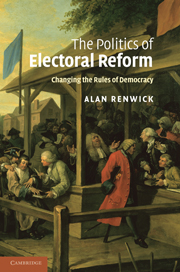Book contents
- Frontmatter
- Contents
- List of tables
- List of figures
- List of abbreviations
- Acknowledgements
- 1 Introduction
- PART I Building blocks
- PART II Elite majority imposition
- 5 France: the recurrent game of electoral reform
- 6 Italy: the search for stability
- 7 Japan: the persistence of SNTV
- 8 Elite majority imposition: comparative analysis
- PART III Elite–mass interaction
- Appendix: glossary of electoral system terminology
- Bibliography
- Index
5 - France: the recurrent game of electoral reform
Published online by Cambridge University Press: 04 May 2010
- Frontmatter
- Contents
- List of tables
- List of figures
- List of abbreviations
- Acknowledgements
- 1 Introduction
- PART I Building blocks
- PART II Elite majority imposition
- 5 France: the recurrent game of electoral reform
- 6 Italy: the search for stability
- 7 Japan: the persistence of SNTV
- 8 Elite majority imposition: comparative analysis
- PART III Elite–mass interaction
- Appendix: glossary of electoral system terminology
- Bibliography
- Index
Summary
France has changed the electoral system used for its national lower house at least as often as any other country: Colomer (2004a: 74–6) counts nineteen cases stretching back to 1789, a number rivalled only by Greece. As Pickles (1958: 33) remarks dryly, ‘Passing new electoral laws is a traditional pastime of French parliaments.’ The two-round system in single-member districts was used for most of the life of the Third Republic, between 1871 and 1940, but was intermittently dropped in favour of various alternatives (Cole and Campbell 1989: 48–71). This chapter encompasses seven episodes of reform or proposed reform since the end of the Second World War, as summarized in Table 5.1.
The adoption of proportional representation, 1945–1946
France emerged from the Second World War under a provisional government headed by General Charles de Gaulle that included all the major political parties. The choice of electoral system over the following eighteen months proceeded in three distinct stages. First, a new electoral system was chosen for a constituent assembly, elected in October 1945. Second, that assembly proposed an electoral system to be used for elections to the future National Assembly, a proposal that lapsed when the draft constitution was rejected by referendum in May 1946. Third, a second constituent assembly, created following the referendum defeat, drafted a somewhat revised electoral system in conjunction with a second draft constitution, accepted by referendum in October 1946.
- Type
- Chapter
- Information
- The Politics of Electoral ReformChanging the Rules of Democracy, pp. 89 - 110Publisher: Cambridge University PressPrint publication year: 2010



